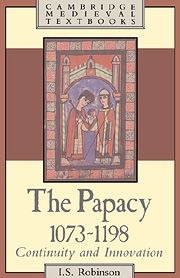Book contents
- Frontmatter
- Contents
- Preface
- List of abbreviations
- BIBLIOGRAPHICAL NOTE
- PART I THE PAPAL GOVERNMENT
- 1 Rome and the Patrimony of St Peter
- 2 The college of cardinals
- 3 Papal councils
- 4 Papal legates
- 5 Papal justice and papal legislation
- 6 The papacy, the religious orders and the episcopate
- 7 Papal finance
- PART II THE PAPACY AND THE SECULAR POWERS
- Appendix A list of popes, 1073–1198
- Index
2 - The college of cardinals
Published online by Cambridge University Press: 05 June 2012
- Frontmatter
- Contents
- Preface
- List of abbreviations
- BIBLIOGRAPHICAL NOTE
- PART I THE PAPAL GOVERNMENT
- 1 Rome and the Patrimony of St Peter
- 2 The college of cardinals
- 3 Papal councils
- 4 Papal legates
- 5 Papal justice and papal legislation
- 6 The papacy, the religious orders and the episcopate
- 7 Papal finance
- PART II THE PAPACY AND THE SECULAR POWERS
- Appendix A list of popes, 1073–1198
- Index
Summary
THE STRUCTURE OF THE COLLEGE
In the second half of the eleventh century the papacy broke away from the narrow preoccupations of the diocese of Rome and began to make good its claims to a universal jurisdiction throughout Christendom. Simultaneously, in the years 1050–1100 the Roman cardinalate ceased to be a local institution of the city of Rome and became an institution of the universal Church: the college of cardinals. Before this transformation took place, the functions of the cardinals had been purely liturgical. The seven ‘cardinal bishops’ – the bishops whose sees were Rome's immediate neighbours – had the duty of performing in turn the weekly services of the Lateran basilica: hence the sources sometimes call them ‘the Lateran bishops’ (episcopi Lateranenses). The title of ‘cardinal’ was also borne by the twenty-eight priests who presided over the titular churches within the city walls. They were responsible for the weekly services in the four patriarchal basilicas, seven cardinal priests serving in turn in each of the basilicas of St Peter, St Paul, S. Maria Maggiore and St Laurence within the walls: hence the sources call them ‘cardinals of St Peter, of St Paul, of St Mary and of St Laurence’. The ‘cardinal’ title belonged also to nineteen (by the later eleventh century, eighteen) deacons: the seven diaconi palatini who served in the Lateran palace and basilica, consisting of the Roman archdeacon and the six palatine deacons, together with the twelve diaconi regionarii.
- Type
- Chapter
- Information
- The Papacy, 1073–1198Continuity and Innovation, pp. 33 - 120Publisher: Cambridge University PressPrint publication year: 1990



